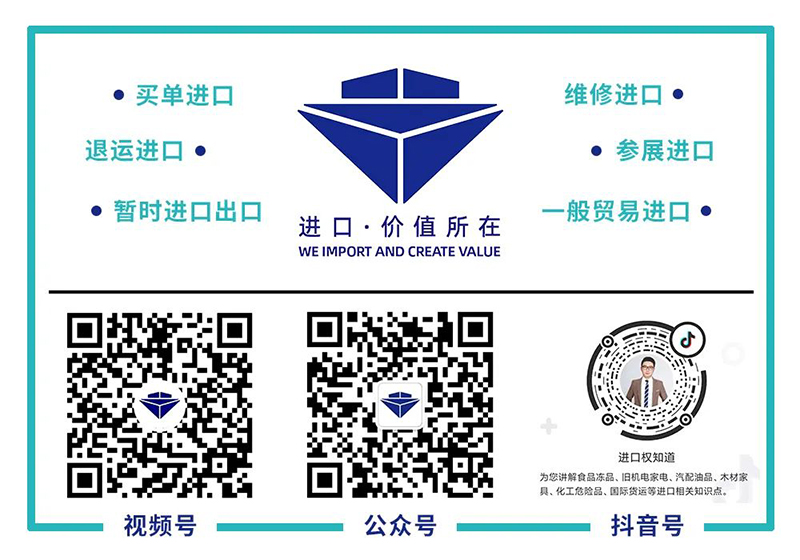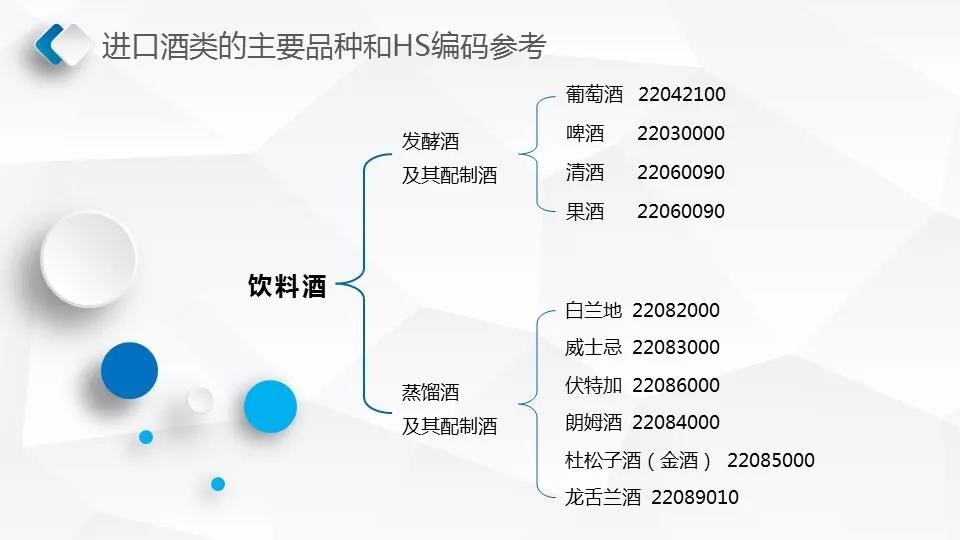1. Main varieties of imported alcohol
2. Preliminary import qualification
1. Registration of the consignee and consignor of import and export goods
materials needed:
(1) The applicant shall submit an application and submit materials to the local customs.
(2) The local customs shall review the application submitted by the applicant, and if the materials are complete and meet the statutory requirements, the customs shall issue the "Customs Import and Export Goods Consignee and Consignor Record Receipt".
(3) If an enterprise applies for the record registration of the consignee and consignor of import and export goods through the “multi-certificate integration” method when handling the industrial and commercial registration, the customs can complete the enterprise registration after confirming the receipt of the enterprise industrial and commercial registration information and business record information , No need to go to the customs for filing and registration procedures.
URL:
China International Trade Single Window https://www.singlewindow.cn/
Or Internet + Customs http://online.customs.gov.cn/
2. Filing of imported food importers
materials needed:
(1) "Importer Filing Application Form"
(2) Organizational structure, department functions and job responsibilities related to food safety
(3) Types of food to be operated and storage location
(4) Those who have been engaged in food import, processing and sales within 2 years shall provide relevant explanations (food variety and quantity)
Handling process:
(1) The enterprise submits a filing application to the local competent customs;
(2) After review by the competent customs where the company is located, those that meet the requirements will be filed and the list of domestic importers will be published, and those that do not meet the requirements will be returned to the company (the company can modify the application information and submit it again).
Information changes:
When there is a change in the record information of the importer that has been filed, the change application shall be submitted to the customs in time. Refer to the filing application for the handling process.
Processing time limit:
If the filing application materials are complete, the customs shall complete the filing within 5 working days from the date of accepting the application.
3. How to declare alcohol imports
1. Application URL
China International Trade Single Window https://www.singlewindow.cn/
Or Internet + Customs http://online.customs.gov.cn/
2. Import declaration information
1. Necessary documents such as contract, invoice, packing list, bill of lading (shipment), etc.;
2. The name and record number of the overseas exporter or agent, importer of imported alcohol, and the import and sales records of the previous batch;
3. Certificate of Origin (Certificate) (Certificates of origin of wine exported from the United States and Japan to China should be provided by the government);
4. Qualified certification materials (such as health certificates) required by laws and regulations, bilateral agreements, protocols and other regulations;
5. Independent inspection report of designated relevant imported food enterprises;
6. Imported food safety commitment documents;
7. Applicable standard statement: Importing alcohol for which there is no national food safety standard shall provide a license certificate issued by the health administration department (Health Commission) of the State Council;
8. Other certificates or documents that should be attached. The implementation of paperless declaration shall be carried out in accordance with the relevant requirements of paperless.
3. Conformity assessment (imported alcohol)
1. The declaring enterprise submits a declaration application to the customs and submits relevant materials. Log in to the China International Trade Single Window (https://www.singlewindow.cn) for customs declaration and upload the accompanying materials in electronic form. The customs will review the declaration materials, accept those that meet the requirements of the regulations, and notify the enterprises to make corrections if they do not meet the requirements.
2. Implement inspection and quarantine. Imported food shall be assessed by the customs in accordance with relevant laws and regulations on import and export food safety.
3. If the imported food meets the requirements through the conformity assessment, the customs will issue the "Inbound Goods Inspection and Quarantine Certificate" (currently realized electronically, enterprises can log in to the "International Trade Single Window" to inquire electronic information and self-download). If the requirements are not met, and the safety, health, and environmental protection items are not qualified, the customs shall issue an "Inspection and Quarantine Treatment Notice" and order the parties to destroy it, or issue a return processing notice, and the importer shall handle the return procedures. If other items are unqualified, they can be technically processed under the supervision of the customs, and can only be sold and used after being re-inspected and qualified.
4.the elements of the standard declaration of imported alcohol
(1) Consignees of imported goods and their agents should strictly follow the requirements of the "Regulatory Declaration Catalog", and should fill in the corresponding content in the "Commodity Name" and "Specification Model" columns based on the actual imported wine label.
(2) When importing goods, the consignee and its agent shall not only submit the documents and materials required by the current customs regulations, but also submit the color photo or color print of the wine label and the original manufacturer's invoice to the customs.
11 declaration elements (take wine as an example):
1. Product name (name in Chinese and foreign languages)
The name of the wine must be filled in both Chinese and foreign names. The name of the wine is generally "xxxx winery dry red/sweet white", etc., with the name of the winery in the front and the type of wine, dry or sweet, red wine or white wine, etc. .
2. Processing method
Refers to the specific methods adopted in the processing of commodities. For example, the wine of 22041000 is filled with "fresh grape brewing"; the commodity of tax heading 2207 is filled with "unmodified" or "modified".
3. Alcohol concentration
Refers to the percentage of alcohol by volume, expressed in "%vol", and reported according to the wine label.
4. Level
Refers to the distinction of wine grades.
There are statutory classifications and industry association classifications for European wines. For example, France has AOC, IGP, and VDF, and Italy has DOCG, DOC, IGT, and VDT. If there is no level division, fill in "No level".
5. Year
Refers to the harvest year of the grapes used to make wine, not the bottle year of the wine. On the wine label, the year of the bottle is usually written. There are also many wines without vintage indication, such as champagne, sherry, etc., which are obtained through blending. If the year is not indicated, the declaration is "None".
6. Production area (name in Chinese and foreign languages)
Refers to the wine producing area indicated on the wine label. Both Chinese and foreign names must be reported. In countries such as France and Italy, the production area is usually written along with the grade.
7. Winery name (name in Chinese and foreign languages)
Refers to the name of the winery producing or storing the wine, which must be reported in both Chinese and foreign languages.
8. Grape varieties (names in Chinese and foreign languages)
Refers to the name of the specific grape variety used to make wine, which must be reported in both Chinese and foreign languages. Australia, the United States and other producing countries require that a bottle of wine contains more than 75% of a certain grape before the name of the variety can be marked on the bottle; countries such as Germany and France require that if a certain grape variety appears on the wine label, it means At least 85% of the wine is made from this grape.
9. Packing specifications
Refers to the quantity or weight of a single commodity, and the specific packaging and specifications should be indicated.
Retail packaging wine, specify: unit packaging capacity x number of units per package/packaging unit, such as 750 ml/bottle x 6 bottles/carton
Bulk non-retail packaging wine, specify: x liter/barrel or x liter/container tank.
10. Please specify if the original liquid is imported or the original bottle is imported
Refers to the packaging state of wine at the time of import.
The import of raw liquor refers to the packing of foreign bulk wine in vats or bags, and the imported and transported to the domestic bottling place before bottling and bottling.
Original bottle import refers to a bottle of wine, from grape planting, picking, juicing, fermentation, cellaring, wine bottling and internal and external packaging are all completed in foreign production areas, and then declared to enter China for sale.
11. If the original liquid is imported, please indicate the filling location, and if the original bottle is imported, please declare the trademark status
If the original liquid is imported, the filling location must be indicated, whether it is processed or repackaged in the bonded area or processed or repackaged outside the bonded area.
If the original bottle is imported, the trademark status must be declared. If there is a trademark right to import, the Chinese and English trademarks of the brand are indicated. When entering the zone without a brand without trademark rights, the label is marked "small-label import".
5. Pre-packaged food labels for imported alcohol
According to the Announcement on Matters Concerning the Supervision and Administration of Import and Export Prepackaged Food Labels issued by the General Administration of Customs No. 70 of 2019, the label filing requirements for the first imported prepackaged food will be cancelled from October 1, 2019. Imported alcoholic beverages are imported foods, so the labeling of alcoholic pre-packaged foods is subject to this regulation.
Importers should pay attention to the following points:
Pre-import review
Importers shall be responsible for reviewing whether the Chinese labels of their imported pre-packaged foods are compliant.
Sampling at import
As one of the food inspection items, the label of imported pre-packaged food shall be inspected by the customs in accordance with the relevant laws and administrative regulations on food safety and import and export commodity inspection.
Post-mortem
If the customs receives notifications from relevant departments and consumers report that the labels of imported pre-packaged foods are suspected of violating relevant regulations, they shall verify and, once confirmed, handle them in accordance with the law.
Scope of application
The new label inspection regulations only apply to pre-packaged foods imported by general trade, such as entry display, samples, duty-free operations (except for outlying islands duty-free), embassies and consulates for personal use, passengers carrying, and entry through mail, express mail, cross-border e-commerce, etc. The supervision of the labeling of pre-packaged foods shall be implemented in accordance with relevant regulations.


